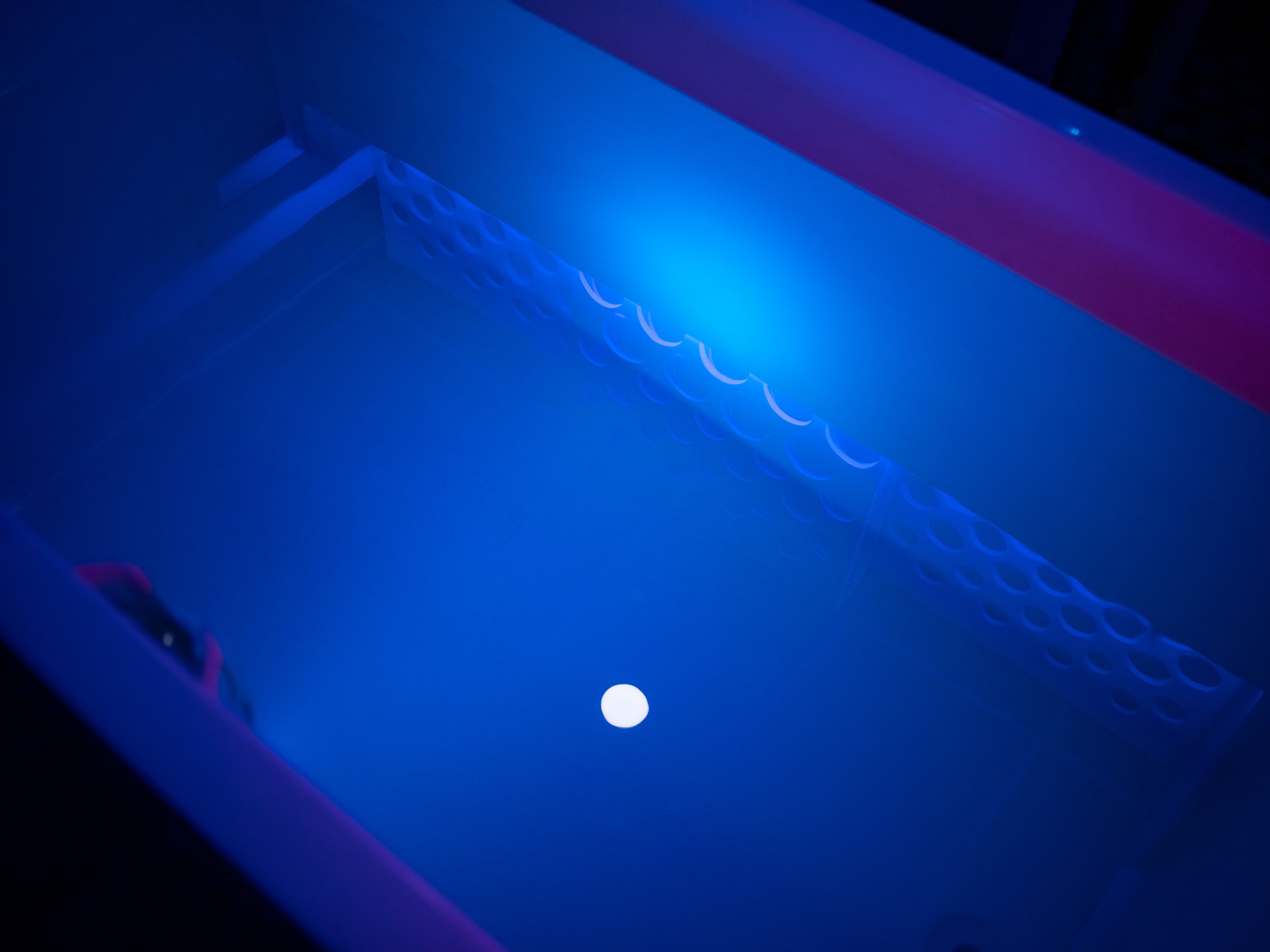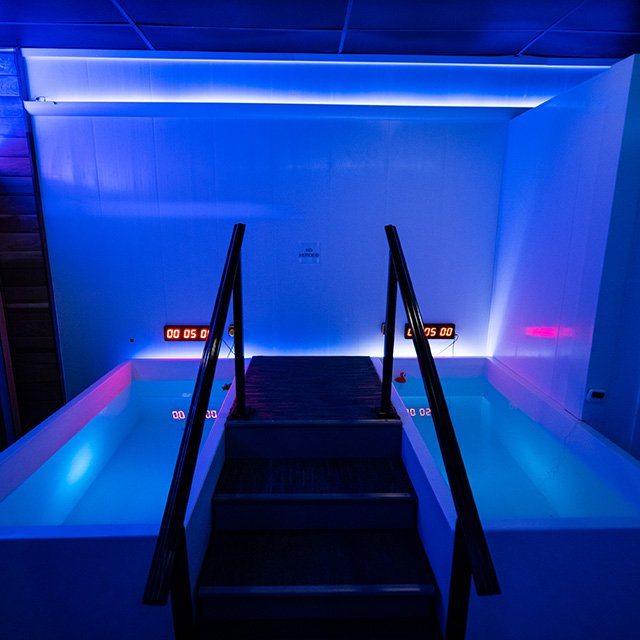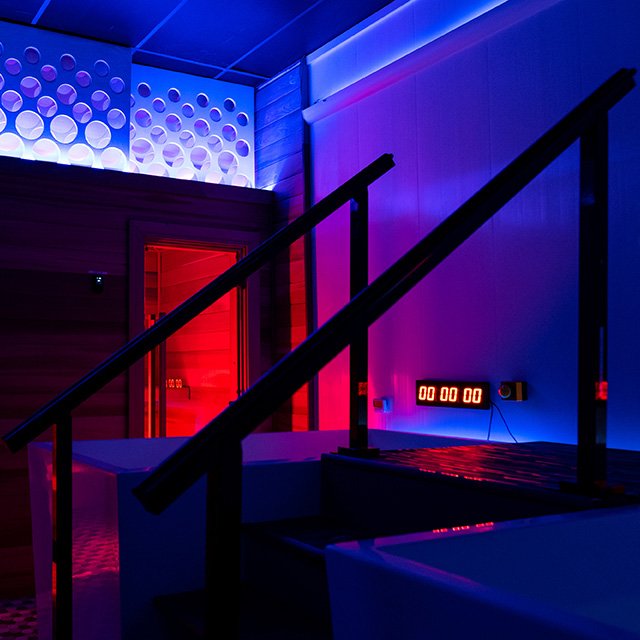
Cold PLUNGE & Contrast Therapy

At Evolve we feature 3-4 cold plunge tanks at different temperatures to access at your own pace. Our Ice Baths are paired with multiple sauna options to enhance your experience.
No appointments ever required!
What is the Cold Plunge and what is Contrast Therapy?
Cold Plunge aka Cold Water Immersion (CWI) is the practice of immersing oneself inside a tank of cold water. Made popular by sports trainers and Wim Hof, it improves natural recovery, aids in workout recovery, improves cardiovascular circulation, reduces muscle inflammation, facilitates weight loss, and improves skin tone. We offer oversized tanks that undergo constant circulation and filtration and can fit 1 - 3 people. The most difficult challenges are the most rewarding. Contrast therapy involves combining hot and cold therapies, so in our case, we combine the Norwegian sauna with the cold plunge. We call this the “fire and ice” method.
How it works:
We have multiple Cold Water Immersion (CWI) tanks and a Norwegian sauna. The cold tanks are set so that there are various temperatures for beginners to more avid plungers. If this will be your first time trying the practice, we recommend using a less-cold one to see how your body responds. There is a timer to make sure you don’t overstay in the cold plunge. All services are on a first-come, first-served basis. We recommend transferring back and forth between the Cold Water Immersion (CWI) and the Norwegian sauna for approximately 15 minutes.
Why get in the cold water tank? Why contrast therapy?
Hormetic stress optimizes you into a stronger, more resilient, and healthier human, both mentally and physically. Sometimes, we struggle with emotional, mental, or physical conditions that weigh us down or make life feel overwhelming. The cold water immersion happens to be a complete reset and nudges us toward healthier and happier states of being. There are so many reasons to make this a routine: detoxification, increased metabolism, immune system and cardiovascular support, weight loss, improved circulation, and skin rejuvenation.

BENEFITS
Shorten Recovery Time
Lower Inflammation
Relieve Pain
Improve mood
Enhance energy
FREQUENTLY ASKED QUESTIONS
-
We have two cold plunges that we keep at two different temperatures. We consider one the beginner tank and one the advanced. At this time we keep the beginner tank between 55-58 ℉ and the advanced tank 40-45 ℉.
-
The maximum we recommend is 5 minutes. You will see a sign that says “No Heros” above the plunges. This means it’s not about who can stay in longer, but about safely pushing ourselves to overcome a challenge. It’s about building resilience, not showing off. Science has shown that 2 minutes is a good goal. At two minutes systems in our body are affected, and after 5 minutes the benefits decrease.
-
How do you clean the water? The water in our cold plunges is constantly filtering to create a completely sanitary pool of water. The filtration includes UV light that can kill bacteria and viruses. We also use hydrogen peroxide as a sanitizing agent which is more effective than chlorine when combined with UV, but much gentler on the skin.
-
Much like working out our muscles, other systems in the body are strengthened when they are stressed in a controlled environment. Heat and Cold are safe ways to stress our cardiovascular system, respiratory, immune system, and energy production systems. Cold plunges have been shown to lower inflammation, boost metabolism, accelerate recovery from workouts, improve sleep, boost your mood, increase energy, and support the immune system. It’s hard getting in, but you will feel amazing after.
-
We believe that cold plunges are a safer, less expensive, and more effective way to cool the body. The thermal conductivity of water is 25 times greater than air, so humans lose body heat up to five times more quickly in water compared to the same temperature in air. So while Cryotherapy can show temperatures under 250 ℉, it’s not as impactful on our physiology as water under 60 ℉.
-
Cold plunging is safe for individuals in good health. If you have any health concerns relating to getting into cold water it is best to consult your doctor. Cold water immersion is not recommended if you have abnormal/altered skin sensation, Impaired circulation: tissue damage may result from vasoconstriction, open wounds / broken skin, hypersensitivity to cold, such as Raynaud’s phenomenon, cold urticaria, cryoglobulinemia, and paroxysmal cold hemoglobinuria, angina pectoris or other severe cardiac diseases, peripheral vascular disease, under influence of drugs or alcohol, or epilepsy.
-
Ice Bath
Cold Water Immersion (CWI)
Cold Therapy
Cold Immersion
-
Contrast therapy is the process of exposing the body to rounds of hot and cold environments. This can be done using air or water. At Evolve we offer cold plunge tanks with water ranging from 44-58 degrees and both traditional and infrared saunas.
-
Contrast Therapy can offer improved circulation, decreased swelling, reduced inflammation, improvement in muscle strains, increased range of motion, reduced muscle soreness, increased energy & alertness, and elevated mood.
-
For healthy individuals contrast therapy is safe. It is recommended to read up on contraindications for saunas and cold plunges before trying contrast therapy.
-
The debate continues on whether to start with hot or cold and how long to do each. A good place to start might be 2 minutes in the ice bath, 15 minutes in the Norwegian sauna then repeat two or three times.
-
Cold to hot therapy has also been found to increase muscle strength post-recovery as well. Athletes exposed to contrast therapy had a higher 1-rep max on the leg press, more muscle power (as measured by isometric force), and performed better on the jump squat compared to recreational athletes who were not receiving the therapy.
-
When you submerge part or all of your body in cold water, small blood vessels called capillaries respond to the cold by getting smaller. This is known as vasoconstriction, and when you warm the body, the opposite happens. Your blood vessels open up. This is known as vasodilation. So, how do these circulatory changes help you? When you rapidly alternate between hot and cold, your blood vessels open and close in a pulsing, pump-like motion. Some proponents think this pumping action can help relieve various injury symptoms and help with muscle recovery. Two studies conducted in 2007 showed that contrast bath therapy can also help decrease the lactic acid in your body, helping you recover from the soreness and fatigue of strenuous exercise.
-
Hot and cold therapy








